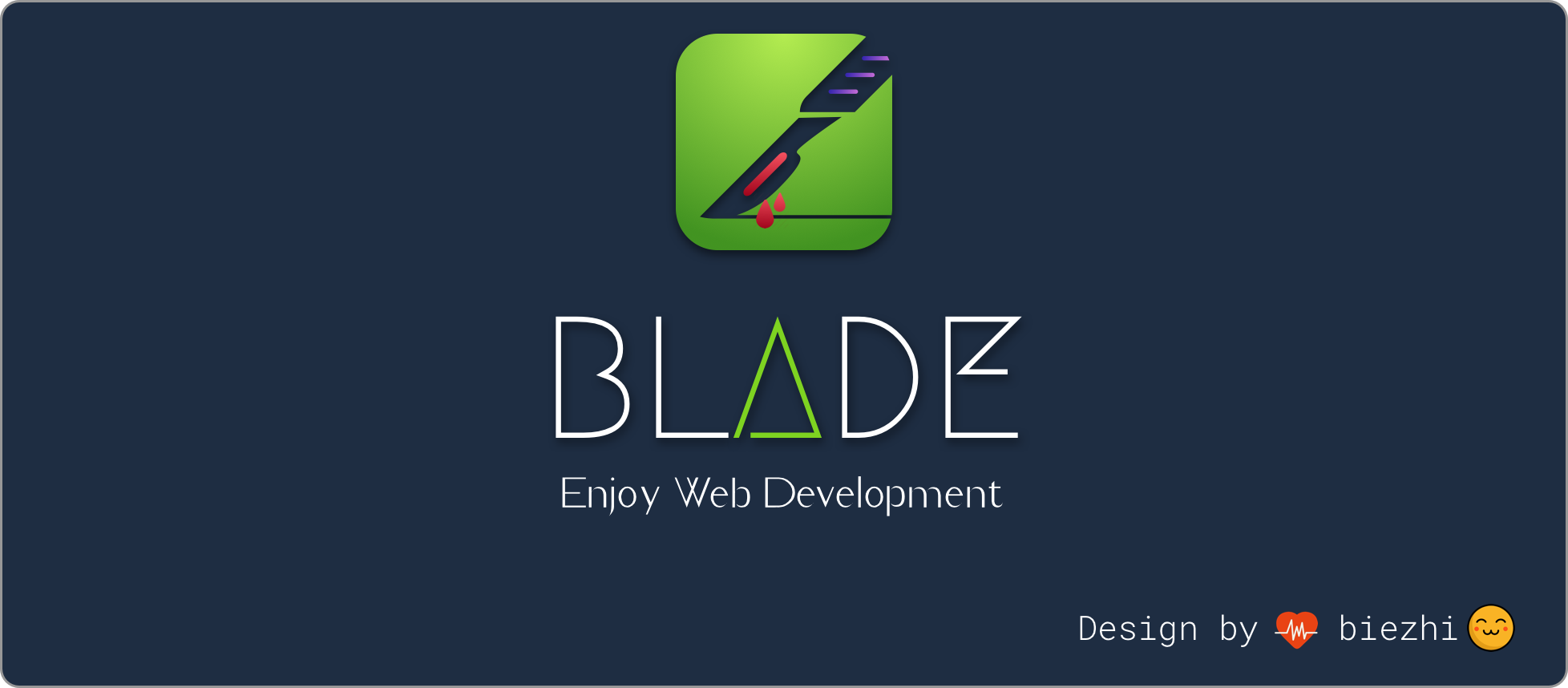基于 Java8 + Netty4 创造的轻量级、高性能、简洁优雅的Web框架 😋
花 1小时 学会它做点有趣的项目,一款除了 Spring 系框架的不二之选。
🐾 快速开始 | 🌚 官方文档 | 💰 捐赠我们 | 🌾 English
Blade 是一款追求简约、高效的 Web 框架,让 JavaWeb 开发如虎添翼,在性能与灵活性上同时兼顾。
如果你喜欢尝试有趣的事物,相信你会爱上它。
如果觉得这个项目不错可以 star 支持或者 捐赠 它 😊
- 新一代MVC框架,不依赖更多的库
- 摆脱SSH的臃肿,模块化设计
- 源码不到
500kb,学习也简单 - Restful风格路由设计
- 模板引擎支持,视图开发更灵活
- 高性能,100 并发下qps 20w/s
- 运行
JAR包即可开启 web 服务 - 支持
CSRF和XSS防御 - 支持
BasicAuth和权限管理 - 流式API风格
- 支持插件扩展
- 支持 webjars 资源
-
cron表达式的定时任务 - 内置多种常用中间件
- 内置JSON输出
- JDK8+
» 简洁的:框架设计简单,容易理解,不依赖于更多第三方库。Blade框架目标让用户在一天内理解并使用。
» 优雅的:Blade 支持 REST 风格路由接口, 提供 DSL 语法编写,无侵入式的拦截器。
» 易部署:支持 maven 打成 jar 包直接运行。
Maven 配置:
创建一个基础的 Maven 工程
<dependency>
<groupId>com.hellokaton</groupId>
<artifactId>blade-core</artifactId>
<version>2.1.2.RELEASE</version>
</dependency>不需要创建
webapp项目骨架, Blade 没这么麻烦。
或者 Gradle:
compile 'com.hellokaton:blade-core:2.1.2.RELEASE'编写 main 函数写一个 Hello World:
public static void main(String[] args) {
Blade.create().get("/", ctx -> ctx.text("Hello Blade")).start();
}用浏览器打开 http://localhost:9000 这样就可以看到第一个 Blade 应用了!
注册路由请求参数获取环境配置获取Header获取Cookie静态资源上传文件下载文件设置会话渲染到浏览器模板渲染重定向写入Cookie路由拦截日志输出Basic认证修改服务端口配置SSL自定义异常处理
public static void main(String[] args) {
// 使用 Blade 实例创建多种路由 GET、POST、PUT、DELETE
Blade.create()
.get("/user/21", getting)
.post("/save", posting)
.delete("/remove", deleting)
.put("/putValue", putting)
.start();
}@Path
public class IndexController {
@GET("/login")
public String login(){
return "login.html";
}
@POST(value = "/login", responseType = ResponseType.JSON)
public RestResponse doLogin(RouteContext ctx){
// do something
return RestResponse.ok();
}
}下面是个例子:
使用 RouteContext 获取
public static void main(String[] args) {
Blade.create().get("/user", ctx -> {
Integer age = ctx.queryInt("age");
System.out.println("age is:" + age);
}).start();
}使用 @Query 注解获取
@GET("/user")
public void savePerson(@Query Integer age){
System.out.println("age is:" + age);
}在命令行下发送数据测试
curl -X GET http://127.0.0.1:9000/user?age=25下面是个例子:
使用 RouteContext 获取
public static void main(String[] args) {
Blade.create().get("/user", ctx -> {
Integer age = ctx.fromInt("age");
System.out.println("age is:" + age);
}).start();
}使用 @Form 注解获取
@POST("/save")
public void savePerson(@Form String username, @Form Integer age){
System.out.println("username is:" + username + ", age is:" + age);
}在终端下发送数据测试
curl -X POST http://127.0.0.1:9000/save -F username=jack -F age=16使用 RouteContext 获取
public static void main(String[] args) {
Blade blade = Blade.create();
// Create a route: /user/:uid
blade.get("/user/:uid", ctx -> {
Integer uid = ctx.pathInt("uid");
ctx.text("uid : " + uid);
});
// Create two parameters route
blade.get("/users/:uid/post/:pid", ctx -> {
Integer uid = ctx.pathInt("uid");
Integer pid = ctx.pathInt("pid");
String msg = "uid = " + uid + ", pid = " + pid;
ctx.text(msg);
});
// Start blade
blade.start();
}使用注解获取
@GET("/users/:username/:page")
public void userTopics(@PathParam String username, @PathParam Integer page){
System.out.println("username is:" + username + ", page is:" + page);
}在终端下发送数据测试
curl -X GET http://127.0.0.1:9000/users/hellokaton/2public static void main(String[] args) {
Blade.create().post("/body", ctx -> {
System.out.println("body string is:" + ctx.bodyToString());
}).start();
}使用 @Body 注解
@POST("/body")
public void readBody(@Body String data){
System.out.println("data is:" + data);
}在终端下发送数据测试
curl -X POST http://127.0.0.1:9000/body -d '{"username":"hellokaton","age":22}'这是 User 类结构
public class User {
private String username;
private Integer age;
// getter and setter
}使用注解获取
@POST("/users")
public void saveUser(@Form User user) {
System.out.println("user => " + user);
}在终端下发送数据测试
curl -X POST http://127.0.0.1:9000/users -F username=jack -F age=16自定义 model 名称
@POST("/users")
public void saveUser(@Form(name="u") User user) {
System.out.println("user => " + user);
}在终端下发送数据测试
curl -X POST http://127.0.0.1:9000/users -F u[username]=jack -F u[age]=16Body 参数转对象
@POST("/body")
public void body(@Body User user) {
System.out.println("user => " + user);
}在终端下发送数据测试
curl -X POST http://127.0.0.1:9000/body -d '{"username":"hellokaton","age":22}'Environment environment = WebContext.blade().environment();
String version = environment.get("app.version", "0.0.1");使用 RouteContext 获取
@GET("header")
public void readHeader(RouteContext ctx){
System.out.println("Host => " + ctx.header("Host"));
// get useragent
System.out.println("UserAgent => " + ctx.userAgent());
// get client ip
System.out.println("Client Address => " + ctx.address());
}使用注解获取
@GET("header")
public void readHeader(@Header String host){
System.out.println("Host => " + host);
}使用 RouteContext 获取
@GET("cookie")
public void readCookie(RouteContext ctx){
System.out.println("UID => " + ctx.cookie("UID"));
}使用注解获取
@GET("cookie")
public void readCookie(@Cookie String UID){
System.out.println("Cookie UID => " + UID);
}Blade 内置了一些静态资源目录,只要将资源文件保存在 classpath 下的 static 目录中,然后浏览 http://127.0.0.1:9000/static/style.css
如果要自定义静态资源URL,可以使用下面的代码
Blade.create().addStatics("/mydir");当然你也可以在配置文件中指定 application.properties (位于classpath之下)
mvc.statics=/mydir使用Request获取
@POST("upload")
public void upload(Request request){
request.fileItem("img").ifPresent(fileItem -> {
fileItem.moveTo(new File(fileItem.getFileName()));
});
}使用注解获取
@POST("upload")
public void upload(@Multipart FileItem fileItem){
// 保存到新位置
fileItem.moveTo(new File(fileItem.getFileName()));
}@GET(value = "/download", responseType = ResponseType.STREAM)
public void download(Response response) throws IOException {
response.write("abcd.pdf", new File("146373013842336153820220427172437.pdf"));
}如果你想在浏览器预览某些文件
@GET(value = "/preview", responseType = ResponseType.PREVIEW)
public void preview(Response response) throws IOException {
response.write(new File("146373013842336153820220427172437.pdf"));
}默认情况不开启会话功能,首先要开启会话
Blade.create()
.http(HttpOptions::enableSession)
.start(Application.class, args);💡 也可以使用配置文件开启,
http.session.enabled=true
public void login(Session session){
// if login success
session.attribute("login_key", SOME_MODEL);
}使用 RouteContext 渲染
@GET("users/json")
public void printJSON(RouteContext ctx){
User user = new User("hellokaton", 18);
ctx.json(user);
}使用注解获取
这种形式看起来更简洁 😶
@GET(value = "/users/json", responseType = ResponseType.JSON)
public User printJSON(){
return new User("hellokaton", 18);
}@GET("text")
public void printText(RouteContext ctx){
ctx.text("I Love Blade!");
}or
@GET(value = "/text", responseType = ResponseType.TEXT)
public String printText(RouteContext ctx){
return "I Love Blade!";
}@GET("html")
public void printHtml(RouteContext ctx){
ctx.html("<center><h1>I Love Blade!</h1></center>");
}or
@GET(value = "/html", responseType = ResponseType.HTML)
public String printHtml(RouteContext ctx){
return "<center><h1>I Love Blade!</h1></center>";
}默认情况下,所有模板文件都 在templates 目录中,大多数情况下你不需要更改它。
默认情况下,Blade使用内置的模板引擎,如果你真的做一个Web项目可以尝试其他几个扩展,这很简单。
public static void main(String[] args) {
Blade.create().get("/hello", ctx -> {
ctx.attribute("name", "hellokaton");
ctx.render("hello.html");
}).start(Hello.class, args);
}hello.html 模板
<!DOCTYPE html>
<html lang="en">
<head>
<meta charset="UTF-8">
<title>Hello Page</title>
</head>
<body>
<h1>Hello, ${name}</h1>
</body>
</html>配置 Jetbrick 模板引擎
实现一个 BladeLoader 加载初始化的操作
@Bean
public class TemplateConfig implements BladeLoader {
@Override
public void load(Blade blade) {
blade.templateEngine(new JetbrickTemplateEngine());
}
}写一点数据让模板渲染
public static void main(String[] args) {
Blade.create().get("/hello", ctx -> {
User user = new User("hellokaton", 50);
ctx.attribute("user", user);
ctx.render("hello.html");
}).start(Hello.class, args);
}hello.html 模板
<!DOCTYPE html>
<html lang="en">
<head>
<meta charset="UTF-8">
<title>Hello Page</title>
</head>
<body>
<h1>Hello, ${user.username}</h1>
#if(user.age > 18)
<p>Good Boy!</p>
#else
<p>Gooood Baby!</p>
#end
</body>
</html>@GET("redirect")
public void redirectToGithub(RouteContext ctx){
ctx.redirect("https://github.com/hellokaton");
}@GET("write-cookie")
public void writeCookie(RouteContext ctx){
ctx.cookie("hello", "world");
ctx.cookie("UID", "22", 3600);
}WebHook 是Blade框架中可以在执行路由之前和之后拦截的接口。
public static void main(String[] args) {
// All requests are exported before execution before
Blade.create().before("/*", ctx -> {
System.out.println("before...");
}).start();
}Blade 使用 slf4-api 作为日志接口,默认实现一个简单的日志(从simple-logger修改),如果你需要复杂的日志记录你也可以使用其他的日志框架,你只需要在依赖关系中排除 blade-log 然后添加你喜欢的。
private static final Logger log = LoggerFactory.getLogger(Hello.class);
public static void main(String[] args) {
log.info("Hello Info, {}", "2017");
log.warn("Hello Warn");
log.debug("Hello Debug");
log.error("Hello Error");
}Blade 内置了几个中间件,当你需要Basic认证时可以使用如下代码,当然也可以定制来实现。
public static void main(String[] args) {
Blade.create().use(new BasicAuthMiddleware()).start();
}在 application.properties 配置文件中指定用户名和密码。
http.auth.username=admin
http.auth.password=123456有三种方式修改端口,硬编码,配置文件,启动命令行参数。
硬编码
Blade.create().listen(9001).start();配置文件 application.properties
server.port=9001命令行
java -jar blade-app.jar --server.port=9001配置文件 application.properties
server.ssl.enable=true
server.ssl.cert-path=cert.pem
server.ssl.private-key-path=private_key.pem
server.ssl.private-key-pass=123456默认情况下,Blade 已经实现了一个异常处理器,有时你需要处理自定义异常,因此你可以尝试像下面这样使用。
@Bean
public class GolbalExceptionHandler extends DefaultExceptionHandler {
@Override
public void handle(Exception e) {
if (e instanceof CustomException) {
CustomException customException = (CustomException) e;
String code = customException.getCode();
// do something
} else {
super.handle(e);
}
}
}这一切看起来多么的简单,不过上面的功能可是冰山一角,查看文档和示例项目有更多惊喜:
- Twitter: hellokaton
- Mail: hellokaton@gmail.com
非常感谢下面的开发者朋友对本项目的帮助,如果你也愿意提交PR,非常欢迎!
请查看 Apache License



